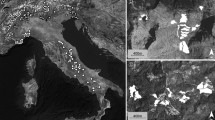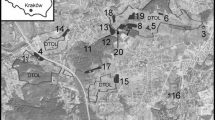Abstract
Currently, many rare and endangered species occur in fragmented habitats. Habitat patch size is often used as an easily measured surrogate of habitat quality and local population size. We investigated whether habitat patch size affects the presence and density of larvae of the endangered dragonfly Aeshna viridis, which for a large part of their life history depend on the macrophyte Stratiotes aloides rosette. The study was performed in four populations, two from Finland and two from Latvia. Our main result was that density of A. viridis and patch occupation increased with area of S. aloides patch. The results may be due to larvae actively avoiding enemies (higher survival) and/or to the possibility that females laid higher number of eggs in the large S. aloides patches. Our results indicate that local abundance and persistence of A. viridis population may depend on the few, large S. aloides patches rather than several small patches of equal total area.



Similar content being viewed by others
References
Anonymous (1992) Council Directive 92/43/EEC of 21 May 1992 on the conservation of natural habitats and of wild fauna and flora. Annex IV (b)
Askew RR (1988) The dragonflies of Europe. Harley Books, Colchester
Berec L, Angulo E, Courchamp F (2007) Inverse density dependence and the Allee effect. Trends Ecol Evol 22:185–191
Clausnitzer V, Kalkman VJ, Ram R, Collen B, Baillie JEM, Bedjanic M, Darwall WRT, Dijkstr KB, Dow R, Hawking J, Karube H, Malikova E, Paulson D, Schüte K, Suhling F, Villanueva RJ, von Ellenrieder N, Wilson K (2009) Odonata enter the biodiversity crisis debate: the first global assessment of an insect group. Biol Conserv 142:1864–1869
Connor EF, Courtney AC, Yoder JM (2000) Individuals-area relationships: the relationship between animal population density and area. Ecology 81:734–748
Corbet PS (1999) Dragonflies: behavior and ecology of Odonata. Harley Books, Colchester
Courchamp F, Clutton-Brock T, Grenfell B (1999) Multiple Allee effects and population management. Trends Ecol Evol 14:405–410
Dennis RLH, Shreeve TG, van Dyck H (2003) Towards a functional resource-based concept for habitat: a butterfly biology viewpoint. Oikos 102:417–426
Dijkstra K-DB (2006) Field guide to the dragonflies of Britain and Europe. British Wildlife Publishing, Dorset
Fahrig L (2003) Effects of habitat fragmentation on biodiversity. Annu Rev Ecol Evol Syst 34:487–515
Flenner I, Sahlén G (2008) Dragonfly community re-organisation in boreal forest lakes: rapid species turnover driven by climate change? Insect Conserv Divers 1:169–179
Franzén M, Nilsson SG (2010) Both population size and patch quality affect local extinction and colonizations. Proc R Soc B 277:79–85
Hanski I (1998) Metapopulation dynamics. Nature 396:41–49
Harabis F, Dolny A (2010) Ecological factors determining the density-distribution of Central European dragonflies (Odonata). Europ J Entomol 107:571–577
Jansson G, Angelstam P (1999) Threshold levels of habitat composition for the presence of the long-tailed tit (Aegithalos caudatus) in a boreal landscape. Landsc Ecol 14:283–290
Keymer JE, Marquet PA, Velasco-Hernández JX, Levin SA (2000) Extinction thresholds and metapopulation persistence in dynamic landscapes. Am Nat 156:478–494
Korkeamäki E, Suhonen J (2002) Distribution and habitat specialization of species affect local extinction in dragonfly Odonata populations. Ecography 25:459–465
Larsson M, Franzén M (2007) Critical resource levels of pollen for the declining bee Andrena hattorfiana (Hymenoptera, Andrenidae). Biol Conserv 134:405–414
Münchberg P (1956) Zur Bindung der Libelle Aeschna viridis Eversm. an die Pflanze Stratiotes aloides L. (Odon.). Nachrichtenblatt der Bayerischen Entomologen 5:113–118
Ovaskainen O, Hanski I (2003) Extinction threshold in metapopulation models. Ann Zool Fenn 40:81–97
Polis GA, Myers CA, Holt RD (1989) The ecology and evolution of intraguild predation: potential competitors that eat each other. Annu Rev Ecol Syst 20:297–330
Rantala MJ, Ilmonen J, Koskimäki J, Suhonen J, Tynkkynen K (2004) The macrophyte, Stratiotes aloides, protects larvae of dragonfly Aeshna viridis against fish predation. Aquat Ecol 38:77–82
Rassi P, Alanen A, Kanerva T, Mannerkoski I (2001) Threatened species in Finland in 2001. Ministry of the Environment and Finnish Environment Institute, Helsinki
Roelofs JGM (1991) Inlet of alkaline river water into peaty lowlands: effects on water quality and Stratiotes aloides L. stands. Aquat Bot 39:267–293
Root RB (1973) Organization of a plant-arthropod association in simple and divrse habitats: the fauna of collards (Brassica oleraceae). Ecol Monographs 45:95–120
Schmidt E (1975) Aeshna viridis Eversmann in Schleswig-Holstein, Bundesrepublik Deutschland (Anisoptera: aeshnidae). Odonatologica 4:81–88
Smolders AJP, Roelofs JGM, den Hartog C (1996) Possible causes for the decline of the water soldier (Stratiotes aloides L.) in the Netherlands. Arch Hydrobiol 136:327–342
Stephens PA, Sutherland WJ (1999) Consequences of the Allee effect for behaviour, ecology and conservation. Trends Ecol Evol 14:401–405
Suhonen J, Hilli-Lukkarinen M, Korkeamäki E, Kuitunen M, Kullas J, Penttinen J, Salmela J (2010) Local extinction of dragonfly and damselfly populations in low and high quality habitat patches. Conserv Biol 24:1148–1153
Suutari E, Rantala MJ, Salmela J, Suhonen J (2004) Intraguild predation and interference competition on the endangered dragonfly Aeshna viridis. Oecologia 140:135–139
Suutari E, Salmela J, Paasivirta L, Rantala MJ, Tynkkynen K, Luojumäki M, Suhonen J (2009) Macroarthropod species richness and conservation priorities in Stratiotes aloides (L.) lakes. J Insect Conserv 13:413–419
Talley TS (2007) Which spatial heterogeneity framework? Consequences for conclusions about patchy population distributions. Ecology 88:1476–1489
Toivonen H (1985) Changes in the pleustic macrophyte flora of 54 small Finnish lakes in 30 years. Ann Bot Fenn 22:37–44
Toivonen H, Bäck S (1989) Changes in aquatic vegetation of a small eutrophicated and lowered lake (Southern Finland). Ann Bot Fenn 26:27–38
Turlure C, Choutt J, van Dyck H, Baguette M, Schtickzelle N (2010) Functional habitat area as a reliable proxy for population size: case study using two butterfly species of conservation concern. J Insect Conserv 14:379–388
Van Buskirk J (1989) Density-dependent cannibalism in larval dragonflies. Ecology 70:1442–1449
Van Buskirk J (1992) Competition, cannibalism, and size class dominance in a dragonfly. Oikos 65:455–464
Wissinger SA (1992) Niche overlap and the potential for competition and intraguild predation between size-structured populations. Ecology 73:1431–1444
Acknowledgments
We thank the Finnish Environment Institute and Regional Environment Centres of Häme, Kaakkois-Suomi and Pirkanmaa for the study permissions. We are grateful to the Jenny and Antti Wihuri Fund (ES), the Ministry of Environment (JS), the Academy of Finland (JS), the Finnish Cultural Foundation (Häme, JS and Varsinais-Suomi, KMK), and Societas pro Fauna et Flora Fennica (ES, KMK) for financing our studies. We are thankful to Mikus Abolins-Abols and Todd M. Freeberg for valuable comments and check of the English.
Author information
Authors and Affiliations
Corresponding author
Rights and permissions
About this article
Cite this article
Suhonen, J., Suutari, E., Kaunisto, K.M. et al. Patch area of macrophyte Stratioites aloides as a critical resource for declining dragonfly Aeshna viridis . J Insect Conserv 17, 393–398 (2013). https://doi.org/10.1007/s10841-012-9521-0
Received:
Accepted:
Published:
Issue Date:
DOI: https://doi.org/10.1007/s10841-012-9521-0




